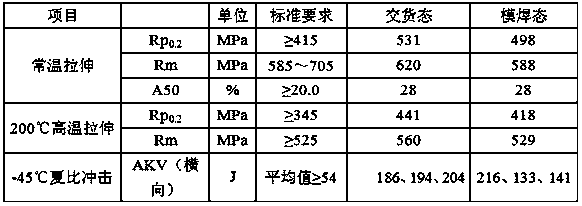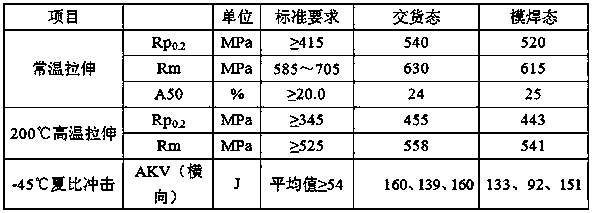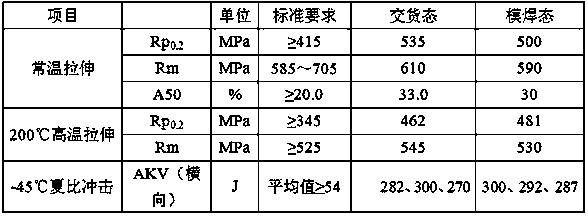Low-carbon-equivalent steel plate for nuclear containment as well as production method of steel plate
A nuclear containment and production method technology, applied in the field of metallurgy, can solve the problems of reducing the mechanical properties of steel plates and difficult to guarantee performance, and achieve the effect of improving the toughness of the matrix and uniform and fine grains
- Summary
- Abstract
- Description
- Claims
- Application Information
AI Technical Summary
Problems solved by technology
Method used
Image
Examples
Embodiment 1
[0020] The thickness of the steel plate for low-carbon equivalent nuclear containment in this example is 20 mm, and its chemical composition and mass percentage are: C: 0.10%, Si: 0.25%, Mn: 1.27%, P: 0.005%, S: 0.002% , Cr: 0.19%, Ni: 0.24%, Cu: 0.080%, Mo: 0.21%, Nb: 0.020%, V: 0.003%, Alt: 0.028%, the balance is Fe and unavoidable impurities, carbon equivalent CEV= 0.41%.
[0021] The production method of the steel plate for low-carbon equivalent nuclear containment in this embodiment includes smelting, billet heating, billet rolling, and steel plate heat treatment processes, and the specific process steps are as follows:
[0022] (1) Smelting: electric furnace smelting + LF furnace refining + VD vacuum treatment; during LF furnace refining, the white slag retention time is 34 minutes, the total refining time is 58 minutes, and argon blowing is good throughout the process; during VD vacuum treatment, the vacuum degree is 66Pa, and the vacuum Hold time 25 minutes;
[0023]...
Embodiment 2
[0031] The thickness of the steel plate for low-carbon equivalent nuclear containment in this example is 38 mm, and its chemical composition and mass percentage are: C: 0.09%, Si: 0.29%, Mn: 1.28%, P: 0.006%, S: 0.002% , Cr: 0.17%, Ni: 0.28%, Cu: 0.070%, Mo: 0.25%, Nb: 0.030%, V: 0.007%, Alt: 0.037%, the balance is Fe and unavoidable impurities, carbon equivalent CEV= 0.41%.
[0032] The production method of the steel plate for low-carbon equivalent nuclear containment in this embodiment includes smelting, billet heating, billet rolling, and steel plate heat treatment processes, and the specific process steps are as follows:
[0033] (1) Smelting: electric furnace smelting + LF furnace refining + VD vacuum treatment; during LF furnace refining, the white slag retention time is 30 minutes, the total refining time is 55 minutes, and argon blowing is good throughout the process; during VD vacuum treatment, the vacuum degree is 60Pa, and the vacuum Hold time 23 minutes;
[0034]...
Embodiment 3
[0042] The thickness of the steel plate for low-carbon equivalent nuclear containment in this example is 45 mm, and its chemical composition and mass percentage are: C: 0.10%, Si: 0.34%, Mn: 1.35%, P: 0.006%, S: 0.005% , Cr: 0.20%, Ni: 0.19%, Cu: 0.060%, Mo: 0.15%, Nb: 0.036%, V: 0.002%, Alt: 0.042%, the balance is Fe and unavoidable impurities, carbon equivalent CEV= 0.41%.
[0043] The production method of the steel plate for low-carbon equivalent nuclear containment in this embodiment includes smelting, billet heating, billet rolling, and steel plate heat treatment processes, and the specific process steps are as follows:
[0044] (1) Smelting: electric furnace smelting + LF furnace refining + VD vacuum treatment; during LF furnace refining, the white slag retention time is 35 minutes, the total refining time is 57 minutes, and argon blowing is good throughout the process; during VD vacuum treatment, the vacuum degree is 63Pa, and the vacuum Hold time 25 minutes;
[0045]...
PUM
| Property | Measurement | Unit |
|---|---|---|
| thickness | aaaaa | aaaaa |
| yield strength | aaaaa | aaaaa |
| thickness | aaaaa | aaaaa |
Abstract
Description
Claims
Application Information
 Login to View More
Login to View More - R&D
- Intellectual Property
- Life Sciences
- Materials
- Tech Scout
- Unparalleled Data Quality
- Higher Quality Content
- 60% Fewer Hallucinations
Browse by: Latest US Patents, China's latest patents, Technical Efficacy Thesaurus, Application Domain, Technology Topic, Popular Technical Reports.
© 2025 PatSnap. All rights reserved.Legal|Privacy policy|Modern Slavery Act Transparency Statement|Sitemap|About US| Contact US: help@patsnap.com



